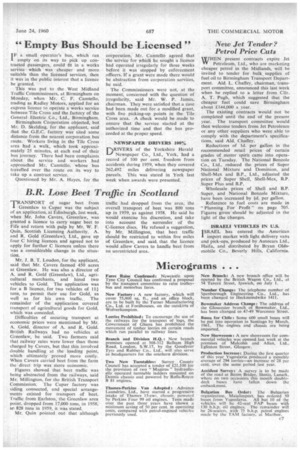B.R. Lose Beet Traffic in Scotland
Page 45

If you've noticed an error in this article please click here to report it so we can fix it.
'TRANSPORT of sugar beet from
Greenlaw to Cupar was the subject of an application, at Edinburgh, last week, when Mr. John Cavers, Greenlaw, was granted a licence to carry sugar beet to Fife and return with pulp by Mr. W. F. Quin, Scottish Licensing Authority. A. and R. Gold (Greenlaw), Ltd., gave up four C hiring licences and agreed not to amity for further C licences unless there was a considerable change in the situation.
Mr. I. B. T. Loudon, for the applicant, said that Mr. Cavers farmed 450 acres at Greenlaw. He was also a director of A. and R. Gold (Greenlaw), Ltd., agricultural merchants, and hired two vehicles to Gold. The application was for a B licence, for two vehicles of 111 tons, to permit their use for Gold, as well as for his own traffic. , The remainder of the application covered transport of agricultural goods for Gold, which was conceded.
Difficulties of securing transport at economic prices were mentioned by Mr. A. Gold, director of A. and R. Gold. British Railways had no vehicles at Greenlaw, he said. Two farmers said that railway rates were lower than those charged by Cavcrs, but that this involved double handling at the loading point, which ultimately proved more costly. When Cavers carried beet from the farm the direct trip was more economic.
Figures. showed that beet traffic was being abstracted from the railways, said Mr. Millington, for the British Transport Commission. The Cupar factory was siding connected, and special arrangements existed for transport of beet. Traffic from Earlston, the Greenlaw area point, dropped from 17,000 tons, in 1958; to 828 tons in 1959, it was stated.
Mr. Quin pointed out that although traffic had dropped from the area, the overall transport of beet was 800 tons up in 1959, as against 1958. He said he would exercise his discretion, and take into account the surrender of the C-licence discs. He refused a suggestion, by Mr. Millington, that beet traffic should be restricted to within live miles of Greenlaw, and said, that the licence would allow Cavers to handle beet from an unrestricted area.












































































































